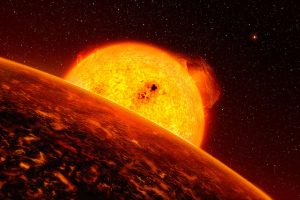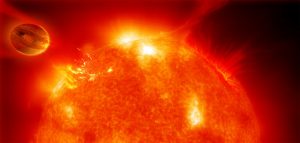
Centaurus constellation (a constellation is simply an arrangement, or configuration, of stars as seen from planet earth) is the place that is starting to bewilder scientists on what is and isn’t possible in the universe as far as start arrangements are concerned.
Centaurus is about 320 light years away from us (a single light year isn’t really a time quantity, but is actually the distance light travels if it is allowed to move non-stop for a whole year) and that is where this strange planet is residing at the moment.
Exoplanets
The planet (or exoplanets because the planets do not exist in our solar system) has about four times more mass than Jupiter (which itself is the biggest planet in our solar system). This weird exoplanet orbits around one of its starts about two times as far out as another planet in the solar system, Pluto.
But here is the strangest part, the exoplanet doesn’t just orbit a single star, it effectively orbits all three in a highly complex manner.
Exoplanets – HD 131399 Ab
The planet is named HD 131399 Ab and is part of a triple star system. To date, there had been only one other triple star system that scientists were able to discover. But even in that old triple star system, the planet in question orbited one bigger star while it kept away from the other two stars.
In this new triple star system, the planet in question is influenced by the gravitational effects of all three stars and that is something scientists were not totally convinced was possible as the planet should have had plenty of problems just to survive in such an arrangement.
Exoplanets – The discovery
The discovery, which was made with the help of highly advanced instruments at European Southern Observatory’s VLT (Very Large Telescope), has been dubbed as an exotic triple star system.
Kevin Wagner, an astronomer and a scientist at the University of Arizona, called it the weirdest orbit of any exoplanets scientists had ever seen. Not only that, he also said that scientists know no other planet that was surviving in a configuration similar to this one.
The discovery was published in an online edition of the journal Science.
Exoplanets and the Science

Because the exoplanets are so far away from us, it becomes near impossible to actually see those exoplanets no matter how big or technologically advanced the equipment is today.
There are very few exoplanets that scientists have been able to discover through direct means because, as some people put it, it is like trying to find a small luminous beetle from a lighthouse that is one thousand miles away from that little beetle.
The only exoplanets that scientists have been able to directly discover through imagery are the exoplanets that are at least bigger than Jupiter, preferably a lot bigger. If the exoplanets have an orbit that is conventional and familiar to the astronomers, then that acts as an added advantage in the discovery process.
Scientists Look for Exoplanets
Scientists also try to look for exoplanets where the shiny reflection of the parent star of the exoplanets is less extreme.
With that said, astronomers have come a long way in terms the technology they are able to leverage now. Instruments have definitely been upgraded to the extent that now scientists have the ability to observe and discover a much wider variety of exoplanets.
The only problem with that is, now, astronomers are coming up against exoplanets that reside in multi-star systems. That means, the light coming from those exoplanets could be from multiple sources and might even be scattered which acts as a hindrance towards discovering new exoplanets.
Exoplanets – SPHERE
But there are some technologically advanced instruments like SPHERE which sports an optics system that is inherently adaptive i.e it can cancel out the negative effects of earth’s atmosphere and the other piece of technology, called chronograph, can help to block light from other stars.
This is the type of engineering that enabled ESO’s (European Southern Observatory) VLT (Very Large Telescope) to spot exoplanets that were simply out of range before.
SPHERE is widely considered to be the most powerful equipment that is currently available for astronomers who hunt exoplanets. It can utilize direct imaging tools that have enabled scientists to spot this extraordinary triple star system for their first try on the new equipment.
The exoplanet in question, HD 131399Ab actually revolves around a relatively young star, the HD 131399A that has been categorized as a type A star. The exoplanet takes around 550 years to complete a single rotation.
Some good distance away, lie the other two stars. One is a sun-like star and the other is a K-dwarf appropriately named B and C respectively. Both of these stars rapidly spin about one another like two spheres connected by the short bar. More like a dumbbell if you will. And if that wasn’t weird enough, you should also know that these two stars also slowly revolve around the big Star A mentioned before.
According to Wagner, the exoplanet is around one third way out of the total distance between Star A and the other pair of two smaller stars (B and C). The scientist also revealed that because the planet is under immense gravitational effects from all three stars, its orbital motion is extremely irregular and is progressively evolving and changing.
The most pressing question, now, is that whether the gravitational pull from the three stars would ultimately destroy/tear/rip the exoplanet. Or may even eliminate the exoplanet from the star system entirely.
Scientists say that the answer to that question would remain a mystery for quite some time. Because even though the HD 131399Ab is a relatively young planet, about 16 million years old (which is an infant in cosmological terms), it is still remarkable that the planet has survived for this long without much damage.
Astronomers now believe that the case of HD 131399Ab suggests that there may be other star systems like this one and there may well be a planet amongst them that is smaller, a bit rockier and more importantly habitable inside those triple star systems.
Wagner also said that, initially, they didn’t really believe that a star system such as this one, would even exist, let alone be as common as it is becoming now.
The extreme configuration of this star system meant that scientists, before, didn’t really bother to look but now that has changed, as studying these exotic triple star systems will, for sure, improve the understanding scientists currently have about the conditions and circumstances in which planets are created and move about.
The team of scientists that discovered this star system is still trying to map out HD 131399Ab’s orbit more accurately and refine it so that it may be determined whether the planet is stable or not.
Exoplanets – Long term future
Long term future of this exoplanet may not be bright but it does beg the question, how would our lives be different if we were to live on such a planet one day.
Wagner is of the opinion that people would see three suns when they are not eclipsing each other. But the planet moves forward in its orbit the stars will continue to move away from each other and that would continue to happen until there comes a point when the rising of one star coincides with the setting of another one.
What that means is that people would experience roundabout two seasons. One where there will be three sunsets and sunrises and another one where there would be non-stop daylight (that would be the case when a setting star would always get replaced by a rising star).
Exoplanets – Conclusion
Whatever becomes of this strikingly odd star system, it has, beyond doubt, captured the imagination of many.